MSI Z87 XPower Review: Our First Z87 with PLX8747
by Ian Cutress on August 12, 2013 9:00 AM EST- Posted in
- Motherboards
- MSI
- PLX
- Z87
System Benchmarks
Rightmark Audio Analyzer 6.2.5
In part due to reader requests, we are pleased to include Rightmark Audio Analyzer results in our benchmark suite. The premise behind Rightmark:AA is to test the input and output of the audio system to determine noise levels, range, harmonic distortion, stereo crosstalk and so forth. Rightmark:AA should indicate how well the sound system is built and isolated from electrical interference (either internally or externally). For this test we connect the Line Out to the Line In using a short six inch 3.5mm to 3.5mm high-quality jack, turn the OS speaker volume to 100%, and run the Rightmark default test suite at 192 kHz, 24-bit. The OS is tuned to 192 kHz/24-bit input and output, and the Line-In volume is adjusted until we have the best RMAA value in the mini-pretest. We look specifically at the Dynamic Range of the audio codec used on board, as well as the Total Harmonic Distortion + Noise.
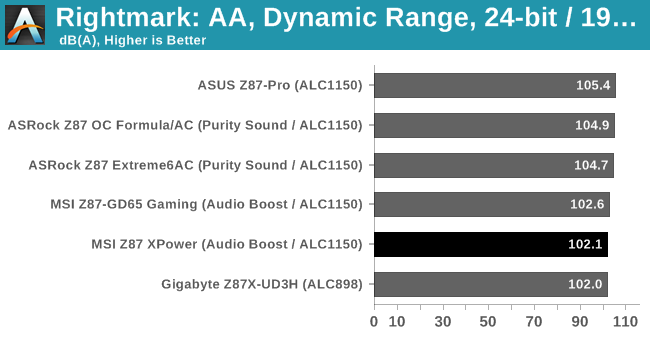
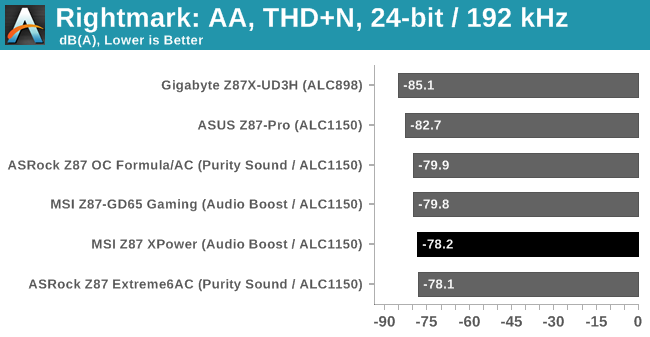
As mentioned in the product overview and visual inspection, while the MSI uses the ALC1150, the traces from the audio codec and DACs have to travel some distance before getting to the gold plated audio jacks. Even though the analog signals in those traces should be separated from the other digital delivery on board, the distance is some 2-4 slots more than other products, resulting in a loss of quality.
USB Backup
For this benchmark, we run CrystalDiskMark to determine the ideal sequential read and write speeds for the USB port using our 240 GB OCZ Vertex3 SSD with a SATA 6 Gbps to USB 3.0 converter. Then we transfer a set size of files from the SSD to the USB drive using DiskBench, which monitors the time taken to transfer. The files transferred are a 1.52 GB set of 2867 files across 320 folders – 95% of these files are small typical website files, and the rest (90% of the size) are the videos used in the WinRAR test. In an update to pre-Z87 testing, we also run MaxCPU to load up one of the threads during the test which improves general performance up to 15% by causing all the internal pathways to run at full speed.
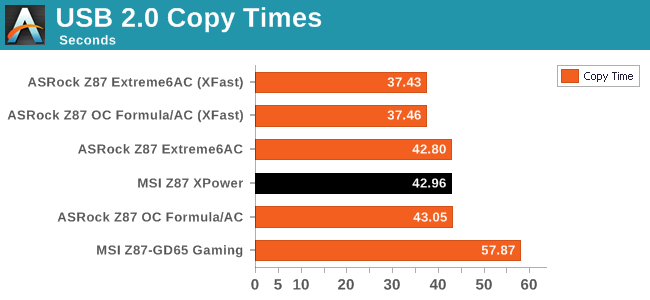
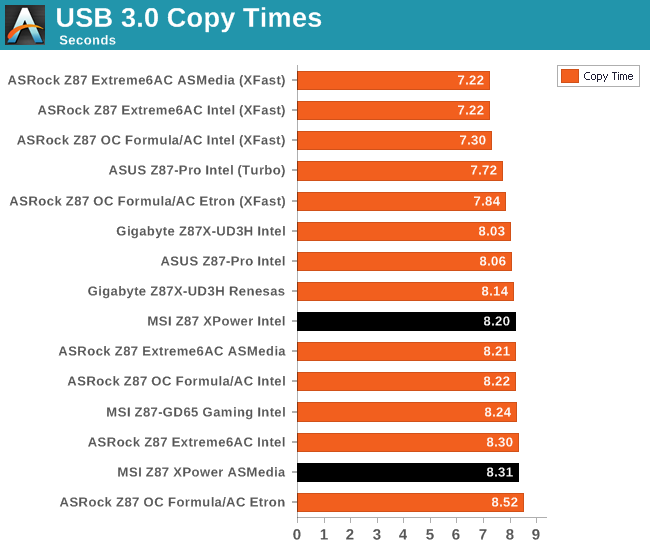
DPC Latency
Deferred Procedure Call latency is a way in which Windows handles interrupt servicing. In order to wait for a processor to acknowledge the request, the system will queue all interrupt requests by priority. Critical interrupts will be handled as soon as possible, whereas lesser priority requests, such as audio, will be further down the line. So if the audio device requires data, it will have to wait until the request is processed before the buffer is filled. If the device drivers of higher priority components in a system are poorly implemented, this can cause delays in request scheduling and process time, resulting in an empty audio buffer – this leads to characteristic audible pauses, pops and clicks. Having a bigger buffer and correctly implemented system drivers obviously helps in this regard. The DPC latency checker measures how much time is processing DPCs from driver invocation – the lower the value will result in better audio transfer at smaller buffer sizes. Results are measured in microseconds and taken as the peak latency while cycling through a series of short HD videos - under 500 microseconds usually gets the green light, but the lower the better.
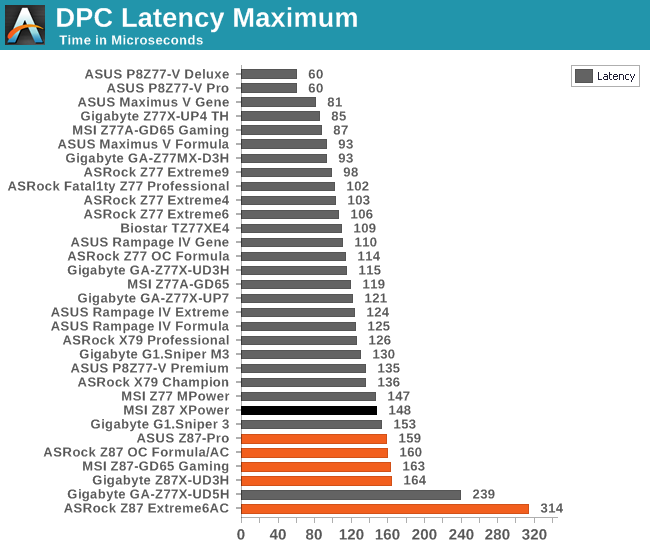
Nothing new here – every Z87 motherboard we have tested so far seems to hit a peak DPC Latency of 150+. MSI sneak in under that, but only just.
WiFi Speeds
With the advent of 802.11ac now part of the motherboard space, it made sense to bring in hardware to test the wireless capabilities of the packages we review. Our test scenario is as follows – the router is located five meters away from the test bed and the signal has to travel through a concrete internal wall. The router is in a flat complex with over 25 access points within 50 meters, mostly on 2.4 GHz. We use a LAN Speed Test server on an i3-3225 based system connected via Ethernet to the D-Link 802.11ac router and then the LAN Speed Test client on the host machine. We set up a one hour continuous test using 10 simultaneous streams each sending then receiving 50 MB across the connection. Results are then plotted as a histogram of the data.
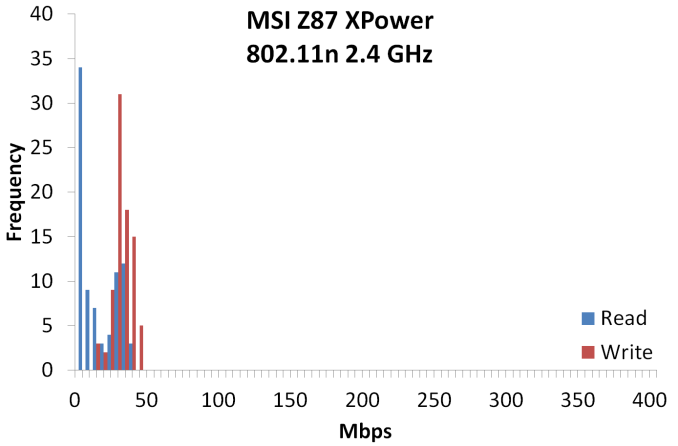
MSI’s bad decision to go with a 2.4 GHz WiFi solution results in a drastically poor WiFi result. In my testing scenario, there are numerous 2.4 GHz access points within range causing interference. 2.4 GHz, as a technology, is essentially dead for video streaming, especially in large cities. I feel MSI were wanting to tick the WiFi box rather than provide a solution, especially when motherboards almost half the XPower’s price come with 802.11ac 5 GHz.










35 Comments
View All Comments
jardows2 - Monday, August 12, 2013 - link
Interesting to read about these high-end boards, but I would like to see someone build a high-end performing board without all the extra "features" that will never get used. 10 SATA ports? Really? If you are doing serious workstation computing and need that many hard drives in a RAID array, you are going to get a SAS RAID controller. If you are just using the computer as a storage server, you won't be spending $400 on the motherboard. All the USB 3.0 ports are going to collect dust for most users. I have several computers with multiple onboard USB ports that have never had anything connected. Add mediocre audio, combined with wireless add-on (practically worthless for such a high-end machine, especially when you have a high-end Ethernet controller on board) it seems like the manufacturers are subscribing to a "more is better" approach, when a "less is more" board, I think, would sell far more. Give me a motherboard with the graphics and overclocking performance that this board can offer, without all the extra stuff, and you will have a winner!529th - Monday, August 12, 2013 - link
Exactly! Well said.Optimalpc - Wednesday, January 29, 2014 - link
ditto that, jardows2! Stick with what a lot of us want - Full x16 bandwidth for GPUs, Good digital Power. Better Audio, including good headphone AMP. Ability to support the fastest memory available. Overclocking with mature tools. Min 3-year warranty. Game Ports. High-end Ethernet controller (Killer). Quit wasting money and real estate on too many SATA ports, USB Ports, sub-par wireless, and crappy audio! I don't need 14 USB ports (or even 8). Hardwired to the network, why even add the cost of wireless at all, UNLESS you are providing the latest in 802.11 standards (ac)?jeffb98 - Monday, August 12, 2013 - link
How's MSI when it comes to Linux? Do they test compatibility at all for at least Red Hat and SUSE enterprise targeted Linux distros? Would they look into/fix BIOS issues when it comes to Linux?I know Asus and Gigabyte tell you they don't do any Linux testing and support when it comes to their consumer motherboards even when there's clearly a Linux compatibility issue. I know most people "never had a problem" but that's most people who don't really do much and probably don't even need a high end board.
nathanddrews - Monday, August 12, 2013 - link
Quad-SLI/CF benchmarks? Seeing as this board caters to people that actually do that kind of thing.IanCutress - Monday, August 12, 2013 - link
My fourth 7970 is in the process of being RMA'ed.Ian
nathanddrews - Monday, August 12, 2013 - link
D'oh! Sorry to hear that.I was about ready to pull the trigger on a 780, but now that the 7990 is only $699 (and with improved drivers), I'm thinking of getting on of those instead given the potential of getting a second in a year or so. Thoughts?
yasamoka - Tuesday, August 13, 2013 - link
Quad-SLi / CF does not always scale too well. Plus you're more likely to hit a CPU bottleneck if you're running any single monitor resolution and hovering above 60FPS with a target of 120FPS.Plus, this: http://www.tomshardware.com/reviews/radeon-hd-7990...
Not recommended except if you water-cool for the heat issues. But then you get left with the other issues. Quad uses AFR + SFR so the microstutter fix is not going to be difficult as it already exists for dual GPU SFR. Quad is similar in that respect as each 2 GPUs use SFR and the groups of 2 GPUs use AFR.
nathanddrews - Tuesday, August 13, 2013 - link
My current setup does most games maxed at 1920x1200@96Hz (at 96fps), but I'm looking to do over 120Hz (at 120fps) with a new 120Hz Lightboost LCD or try out some of the overclockable 1440/1600p displays. My FW900 is going to die someday and I need to be ready. :|rpg1966 - Monday, August 12, 2013 - link
OK, this is probably a dumb question - but as implied on the first page, if this board has an additional 2 sockets of space between the port cluster and the PCIe sockets, won't you need a case that is specifically designed for such a long (tall?) motherboard?